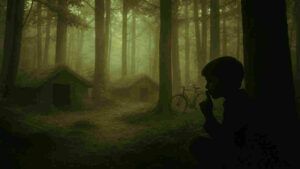How a Hidden Dutch Village Saved Jews during the Holocaust


One of the Netherlands’ tourist attractions is a village hidden deep in the woods, between Vierhouten and Nunspeet. Built in 1943 by members of the Dutch resistance, the village provided shelter to more than a hundred people, most of them Jews.
 A reconstructed hut in the hidden village in Vierhouten. G.Lanting, CC BY 4.0 <https://creativecommons.org/licenses/by/4.0>, via Wikimedia Commons
A reconstructed hut in the hidden village in Vierhouten. G.Lanting, CC BY 4.0 <https://creativecommons.org/licenses/by/4.0>, via Wikimedia Commons
The von Baumhauers
A descendant of a prominent German family, Edouard Henri von Baumhauer worked as a lawyer in Amsterdam and was president of the Holland-America Trade Council. In 1940, when foreign trade was halted due to World War II, Baumahauer and his wife, Hermina Jacoba Johanna (nee Ribbink), decided to move to the countryside with their three children. Edouard and Hermina, ages 50 and 45 respectively, owned a spacious villa outside Vierhouten.
As an international lawyer with an extensive business contact network, Edouard was well aware of the fate the Nazi regime intended for the Jews. He assisted German Jews in emigrating from Germany. In 1941, Edouard and Hermina began hiding Jews in their home. For emergencies, they constructed a 150-yard escape tunnel leading into the nearby woods.
In May 1942, Edouard was arrested and spent over half a year in Sint-Michielsgestel internment camp, set up by the Nazis in the Netherlands. After Hermina’s copious efforts on his behalf, he was finally released.
Meanwhile, more and more Jews were turning to the von Baumhauers, and eventually their 7-bedroom villa became too crowded. After his release, Edouard began looking for other locations where Jewish families could stay safe during the German occupation. He rented additional houses for Jews in the village of Vierhouten. He also wondered if it would be possible to hide Jews in the woods surrounding his home.
One day, Edouard went into the woods to survey the area. There, he met Dionisius Bakker of the nearby village of Nunspeet, who was also considering hiding people wanted by the Nazis in the forest. Baumhauer and Bakker decided to work together.
The Bakkers
Dionisius Bakker was a retired railway conductor and a father of four grown children. After the death of his first wife, he married Cornelia Johanna van Rheenen, who was significantly younger than him.
In 1940, shortly after his retirement at age 61, Dionisius, together with Cornelia, joined the Dutch resistance. They began hiding three anti-Nazi underground activists in their home. In 1942, the Bakkers also hid a Jewish family, the Hertzes, a couple with two daughters.
 Dionisius Bakker
Dionisius Bakker
A few months later, the Nazis broke into the Bakker home. Fortunately, they did not manage to discover their hidden guests. But the Bakkers knew that next time, they might not be so lucky. They began looking for a better hiding place.
That’s how Dionisius Bakker met Edouard von Baumhauer in the woods near his home.
Together, the von Baumhauers and the Bakkers built a hidden village deep in the woods. They put up tents and dug out underground huts. They hired trusted contractors to install water pumps, electricity, and other necessities.
Before long, the village served as a temporary home for dozens of people.
 A memorial to the Bakkers at the site of the hidden village. G.Lanting, CC BY 4.0 <https://creativecommons.org/licenses/by/4.0>, via Wikimedia Commons
A memorial to the Bakkers at the site of the hidden village. G.Lanting, CC BY 4.0 <https://creativecommons.org/licenses/by/4.0>, via Wikimedia Commons
Life in the Hidden Village
At its peak, the village consisted of 13 huts, hidden partially underground, housing over a hundred people. Most of its residents were Jewish,; others included Dutch resistance members, a Russian, a Pole, a German deserter, and shot-down Allied pilots.
The Bakkers, who became known to everyone as Grandpa Bakker and Aunt Cor, supplied the village with provisions and daily necessities, with the help of other resistance members. They collected ration cards and traded them for goods in different places around town, so as not to arouse suspicion. Then they smuggled supplies into the village on bicycles and in carts. They also brought gas tanks for cooking.
Aunt Cor, who got to know every refugee personally, tried to distribute the goods as evenly as possible. She also became the village nurse, taking care of the sick. Among the residents were a doctor and a dentist, but sometimes a patient needed more medical care than could be provided in the forest. Resistance members would carry the patient on a stretcher to a nearby village, from where he or she could be taken to the hospital under an assumed identity.
Grandpa Bakker and Aunt Cor also provided the refugees with warmth and emotional support. According to the Yad Vashem website1, “This became their life… Cornelia and Dionisius acted out of patriotism and love of their fellow man, without any thought of reward.”
The Nazis broke into their home and searched it eight times. Despite the danger, the Bakkers continued their rescue work.
They lived in fear of being discovered by the Nazis. Special rules were put in place in order to avoid detection. The village was split into four parts, and during the day the residents were only allowed to come out into their own part. After nightfall, they were allowed to visit the other three parts and to go to the pump to get water.
Life in the village was especially difficult for children. One of the survivors, Ze’ev Bar, recalls2, “I was a child and had to be quiet all the time and to whisper all day and to whisper is terrible for a child. Because to begin with you have to whisper, but also you cannot become angry and raise your voice.”
The adults tried to teach and entertain the children, despite the circumstances. Another survivor, Leny Duyzend, shares3, “I cannot recall that I was bored, we had Ludo [board game] and that sort of things.”
The residents spent time reading, making pottery, cooking meals, and playing games.
At first, both the residents and the resistance members assisting them took utmost precautions, but with time, they began making careless mistakes.
The village was almost discovered because one of the resistance members took pictures of it. The Germans searched his home and discovered the undeveloped film. Fortunately, they were unable to see the pictures on the film, apparently because they accidentally exposed it to light. However, when the resistance members heard about the confiscated film, they evacuated the whole village. The residents were allowed to return four weeks later.
 Inside a home in the hidden village. G.Lanting, CC BY 4.0 <https://creativecommons.org/licenses/by/4.0>, via Wikimedia Commons
Inside a home in the hidden village. G.Lanting, CC BY 4.0 <https://creativecommons.org/licenses/by/4.0>, via Wikimedia Commons
Discovery
In October 1944, two SS men were out hunting in the forest, when they heard suspicious sounds: somebody was chopping and sawing wood. They followed the sounds and came across a young Jewish boy, Ze’ev Bar.
Bar recalls4, “Suddenly there was a loud shouting, “Raus du Jude, raus, raus” (out, you Jew, out)!”
After firing some warning shots, the Nazis released the boy, perhaps afraid of the unknown force in the forest, and went to get reinforcements. They realized that the hiding place they had stumbled across had significantly more people than the two of them could overpower.
Most residents of the hidden village managed to escape, some of them finding shelter at the von Baumhauers’ villa and others at the Bakkers’ home. Most of them survived the war.
Unfortunately, when the SS men returned with a larger group, they managed to capture eight Jews, whom they cruelly executed. Among the executed was a six-year-old boy.
The Nazis threw grenades into the huts of the hidden village and completely destroyed it.
Dionisius Bakker was arrested at his home by the Nazis in February, 1945. No one else was discovered during his arrest.
Cornelia was on her way back home when saw her husband being taken away. She did not spare any effort to get him released. Unfortunately, she did not succeed. Dionisius was executed on March 2, 1945.
Back in 1944, Dionisius had told the people he was hiding5, “I will sign for all and bear full responsibility for the cause to which we give ourselves. It is better that they catch me, an old man, than all of you, who are still young.” Perhaps by allowing himself to get captured, he saved many other lives.
Though heartbroken by the loss of her husband, Cornelia survived the war. For several years, she was bedridden as a result of a biking accident on her way to deliver supplies to the hidden village. Eventually she recovered.
In 1964, Yad Vashem recognized Dionisius and Cornelia Bakker as Righteous Among the Nations.
Cornelia lived in Nunspeet until her death in 1989. Many people attended her funeral.
The von Baumhauer family survived the war intact. They were also recognized as Righteous Among the Nations by Yad Vashem in 1999.
Today, the site of the hidden village is a tourist attraction. A memorial commemorates the site and its founders. Three huts were rebuilt and are open to visitors.
Sources:
- Hidden Village of Vierhouten. Traces of War. Available at https://www.tracesofwar.com/articles/3272/Hidden-Village-of-Vierhouten.htm, retrieved on February 26, 2025.
- Baumhauer von Edouard & Hermina (Ribbink). Yad Vashem. Available at https://collections.yadvashem.org/en/righteous/4022305, accessed on February 26, 2025.
- Bakker Dionysius & Cornelia (Rheenen van). Yad Vashem. Available at https://collections.yadvashem.org/en/righteous/4036723, accessed on February 27, 2025.
- Bakker, Dionisius Dirk. Available at https://ww2gravestone.com/people/bakker-dionisius-dirk/#google_vignette, accessed on February 27, 2025.
- Bakker Dionysius & Cornelia (Rheenen van). Yad Vashem. Available at https://collections.yadvashem.org/en/righteous/4036723, accessed on February 27, 2025.
- Hidden Village of Vierhouten. Traces of War. Available at https://www.tracesofwar.com/articles/3272/Hidden-Village-of-Vierhouten.htm, retrieved on February 26, 2025.
- Ibid.
- Ibid.
- Bakker, Dionisius Dirk. Available at https://ww2gravestone.com/people/bakker-dionisius-dirk/#google_vignette, accessed on February 27, 2025.
The post How a Hidden Dutch Village Saved Jews during the Holocaust appeared first on Aish.com.
Go to Aish
Date: May 18, 2025


